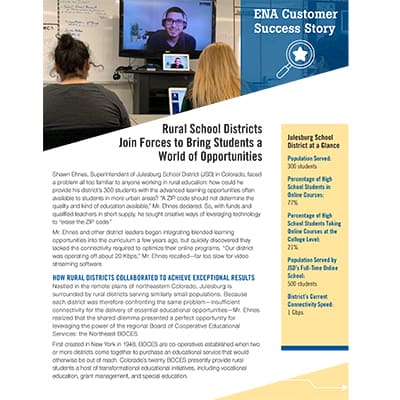Customer Success Story
JULESBURG SCHOOL DISTRICT | JULESBURG, COLORADO
Mr. Ehnes and other district leaders began integrating blended learning opportunities into the curriculum a few years ago, but quickly discovered they lacked the connectivity required to optimize their online programs. “Our district was operating off about 20 Kbps,” Mr. Ehnes recalled—far too slow for video streaming software.
Shawn Ehnes, Superintendent of Julesburg School District (JSD) in Colorado, faced a problem all too familiar to anyone working in rural education: how could he provide his district’s 300 students with the advanced learning opportunities often available to students in more urban areas? “A ZIP code should not determine the quality and kind of education available,” Mr. Ehnes declared. So, with funds and qualified teachers in short supply, he sought creative ways of leveraging technology to “erase the ZIP code.”
Mr. Ehnes and other district leaders began integrating blended learning opportunities into the curriculum a few years ago, but quickly discovered they lacked the connectivity required to optimize their online programs. “Our district was operating off about 20 Kbps,” Mr. Ehnes recalled—far too slow for video streaming software.
Julesburg School District at a Glance
Population Served:
300 students
Percentage of High School Students in Online Courses:
77%
Percentage of High School Students Taking Online Courses at the College Level:
21%
Population Served by JSD’s Full-Time Online School:
500 students
District’s Current Connectivity Speed:
1Gbps
How Rural Districts Collaborated to Achieve Exceptional Results
Nestled in the remote plains of northeastern Colorado, Julesburg is surrounded by rural districts serving similarly small populations. Because each district was therefore confronting the same problem—insufficient connectivity for the delivery of essential educational opportunities—Mr. Ehnes realized that the shared dilemma presented a perfect opportunity for leveraging the power of the regional Board of Cooperative Educational Services: the Northeast BOCES.
First created in New York in 1948, BOCES are co-operatives established when two or more districts come together to purchase an educational service that would otherwise be out of reach. Colorado’s twenty BOCES presently provide rural students a host of transformational educational initiatives, including vocational education, grant management, and special education.

“We’ve seen that if you want to be an island,” said Arlene Salyards, the Northeast BOCES’s Special Projects Director, “you’re not going to be as successful as you will be if you reach out and build a network of people who have similar needs.”

Recognizing the vast opportunities blended and distance learning could afford their students, Ms. Salyards and the districts within the Northeast BOCES worked together to put out an RFP for reliable, high-speed broadband that could be delivered to even the most remote locations in the region.
The Right Partner Makes All the Difference
In her search for the right connectivity partner, Ms. Salyards was guided by a simple principle. “Our BOCES model is to develop a plan that will support all of our districts in the best way possible,” she explained.
In 2017, the Northeast BOCES awarded the contract to ENA, a leading provider of technology solutions to education communities. Through this new collaboration, the Northeast BOCES could offer each of its twelve districts reliable, high-speed Internet at a fraction of the price each one would have paid had it chosen to “be an island.” With exceptional connectivity secured, the region’s schools were no longer forced to carefully ration and schedule their online learning activities. “We don’t even think about that anymore,” Ms. Salyards said. “We just do what we need to do and enjoy knowing the access is always there.”
The schools within the Northeast BOCES immediately felt the benefit of partnering with ENA. “That partnership has been key to us having the confidence we need to expand our blended learning,” Mr. Ehnes said. “Because we now have a connection of 1 Gbps—and reliable service—we’ve been able to expand and further develop our innovative blended learning programs.”
Colorado’s many BOCES, thanks to the collaborative power of the Colorado Education Broadband Coalition (CEBC), have been able to bring these same opportunities to communities statewide. “The Northeast BOCES has become a model for the state,” Ms. Salyards said. Indeed, as the Northeast BOCES has connected with more and more of the state’s other BOCES, more districts are erasing their ZIP codes. “With a network of people who share the same vision as the CEBC,” she explains, “you can make things happen.”
How Robust Connectivity Transforms Lives
After only three years of high-speed connectivity, JSD has already dramatically expanded its educational offerings. One initiative that has been particularly successful is its unique distance-learning strategy. Like many rural districts, JSD has experienced a chronic teacher shortage, so the district turned to its new, BOCES-enabled technology for a solution: the district decided to optimize its robust connectivity and bring remotely located teachers into its classrooms via video conferencing. These instructors, with the assistance of an in-class aide, successfully lead classes of up to 25 students.

I think there are a lot people who probably doubt the effectiveness of this type of distance learning and expect it would never work,” says Satara Ehnes, a senior at JSD. “They don’t realize how appreciative rural students are of these types of opportunities.”

The district has also partnered with Northeastern Junior College to allow students to explore different career paths, participate in advanced courses, and earn college credit. JSD is also leveraging technology to empower gifted and talented students to take higher level courses. Additionally, JSD offers the only state-approved AG-FFA program in which a teacher virtually instructs and runs the FFA chapter. JSD’s virtual educational transformation has proved so effective that the district now offers a full-time online school through which hundreds of Coloradans statewide are pursuing high school diplomas.
Ms. Ehnes has taken full advantage of her district’s new opportunities.

“Robust connectivity is a student’s lifeline,” she explained. “It’s the only way we’re able to complete what we need to do.”

And what she’s done is impressive: “I’ve taken more than twenty online classes at this point, and I will be graduating with an associate’s degree this spring.”
Better still, for Ms. Ehnes the benefits have not been limited to her expanded course catalog. “Blended learning offers students a variety of learning options,” she said. “If you’re a visual learner or an auditory learner, you have an avenue to succeed.” And because Ms. Ehnes has been able to broaden her network to include peers and teachers statewide, she has learned from them as well. She attributes much of her success to this community’s unwavering support
The district’s teachers are equally enthusiastic about the opportunities blended learning affords. “With the new technology, I can deliver content in so many different ways to students based on their needs,” said Beth Vasquez, who virtually teaches social studies at JSD.

“The most important transformation is equal access. Students can access different types of resources and individualize them to their own needs.

Ms. Vasquez also praised the increased safety many students feel in the blended classrooms. “Some students aren’t comfortable raising their hands in front of 20 other students,” she said. “It’s so much easier and comfortable for them to send me a quick email.”
Conclusion — An Innovative Program is Fast Becoming The Norm
JSD’s experience with Colorado’s Northeast BOCES shows how powerful the combination of technology and collaboration can be. Through a strong partnership, the regions districts have transcended the old limitations of geography and budget.
Because blended learning and robust Internet access allow for diverse education experiences at a low cost, those involved in securing powerful connectivity for northeastern Colorado believe that the time when a ZIP code can limit a student’s educational opportunities is coming to an end.

“Technology is allowing us to eliminate the barriers and challenges that often come with living in a rural area,’ says Mr. Ehnes. ‘We are not letting where we live define who we are and limit what we can achieve.”

Indeed, the educational model JSD has mastered is already being adopted far and wide. “Education has changed so much over the last ten years,” said Ms. Salyards. “There is no reason why we cannot engage students or promote collaborative learning in a virtual environment. All you need are teachers and leaders who are willing to try.”
Satara Ehnes’s impressive success is a testament to the transformative effect collaboration and innovation can have on a community. Empowered by the robust infrastructure the Northeast BOCES made possible, Julesburg has developed digital learning programs that are equipping students statewide with the skills they need to succeed in their educational and professional careers.

